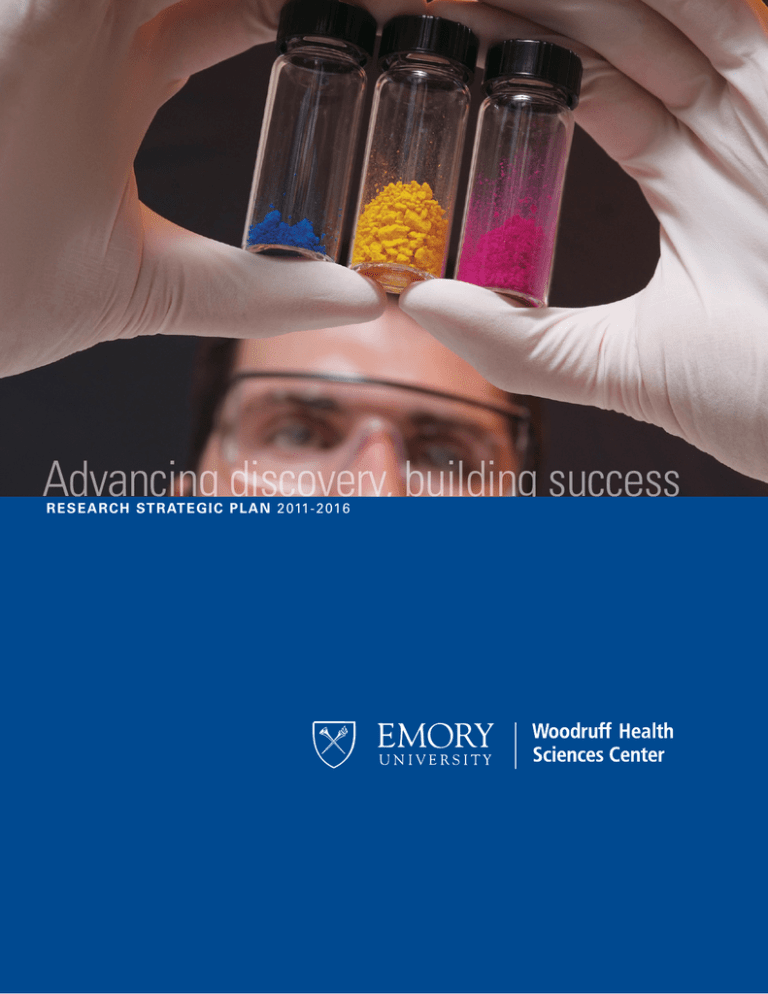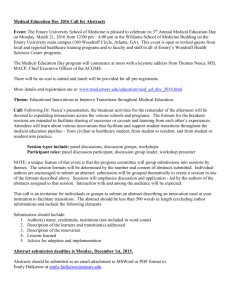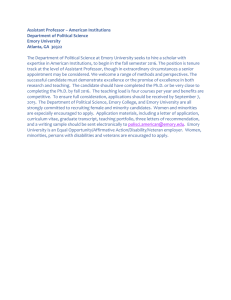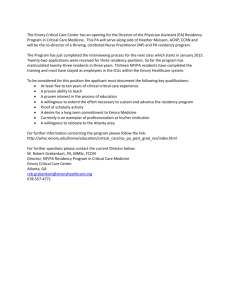Advancing discovery, building success RESEARCH STRATEGIC PLAN 1 Research Strategic Plan
advertisement

Research Strategic Plan 2011 Advancing discovery, building success R E S E ARCH STRATEGIC PL AN 2 011-2 016 |1 2 | WOODRUFF HEALTH SCIENCES CENTER Emory University, led by its Woodruff Health Sciences Center, has emerged over the past few decades as a nationally recognized, research-intensive university driven by outstanding biomedical, public health, and nursing research. Emory discoveries have had a significant impact on improving health and extending life both locally and globally. The strategies outlined in this new research strategic plan focus on building interdisciplinary research and on identifying and creating new areas of discovery. The plan also emphasizes operational improvements and efficiencies and strategic investment in high-potential areas. We will measure our success not only by our ability to create and share new knowledge, but also by the impact of our efforts economically and socially. I invite you to read this brief synopsis of the WHSC Research Strategic Plan as we continue on our path of increasing excellence in health sciences research. Wright Caughman, MD Executive Vice President for Health Affairs, Emory University CEO, Woodruff Health Sciences Center Chairman, Emory Healthcare The impressive growth of biomedical research at Emory University and in the Woodruff Health Sciences Center has resulted from investment of resources, creation of research space, philanthropy, leadership, and strong vision. This growth has been accompanied by numerous groundbreaking discoveries that have changed the course of health around the world. Our continued success will rely on a comprehensive plan to guide our future research strategies, to address significant opportunities, and to take advantage of unique assets. Increasing research excellence in the new world of limited resources and increased competition for funding will require a robust and carefully crafted strategy that aligns with priorities of the National Institutes of Health and our other major funding agencies. Most important, we must ensure that the significant individual research strengths of our Schools of Medicine, Public Health, and Nursing; Yerkes Primate Center; and Emory Healthcare are adequately integrated and synergistic. I am proud of the hard work of the many health sciences faculty involved in creating this new Research Strategic Plan. I am confident that by working together to carry out the strategy outlined here, we will meet the challenges before us and create a bright future of research accomplishment at Emory and in the Woodruff Health Sciences Center. David S. Stephens, MD Vice President for Research, Woodruff Health Sciences Center Stephen W. Schwarzmann Distinguished Professor of Medicine, Emory University School of Medicine Future 2 | WOODRUFF HEALTH SCIENCES CENTER The world’s leading universities contribute to human development by disseminating established knowlege and creating new knowledge through research and discovery. Research excellence is a fundamental goal of Emory University and the Woodruff Health Sciences Center. Research Strategic Plan 2011 | 3 The Future of Research in the Woodruff Health Sciences Center Emory’s groundbreaking successes in biomedical discovery, coupled with extraordinary growth in research funding, infrastructure, and personnel over the past decade provide an opportunity to build even greater research excellence. Maintaining success and building momentum in research in the Woodruff Health Sciences Center will require long-term institutional investment, continual strategic thinking, and a firm appreciation of the immense value of the research enterprise. The WHSC Research Strategic Plan is designed to position the institution for the highest level of achievement in creating and sharing new knowledge. Over the past year more than 100 WHSC research faculty and clinical and academic leaders have worked collaboratively to develop strategies and institutional objectives for research. Their collective voice, which endeavors to translate the value of research into action and progress over the next five years, is reflected in this plan. 4 | WOODRUFF HEALTH SCIENCES CENTER The Value of Research n atients and communities throughout the world benefit P from advances in medicine, public health, and nursing. n Research success creates institutional distinction and a positive reputation locally, nationally, and internationally. n Scientists and trainees generate intellectual capital. n The highest quality faculty are recruited and retained in the presence of research excellence. n Funding, facilities, and jobs related to research serve as an economic engine for the community, city, state, and region. n Jobs for scientists, trainees, and staff result from research. n Emory Healthcare differentiates itself among local and regional providers and enjoys a clinical competitive advantage through providing leading edge treatments. n Discovery is a foundation for growth in fundraising and philanthropy. n Government and foundations provide additional investment in response to research excellence. n Commercialization of intellectual property creates a return on research investment. Research Strategic Plan 2011 | 5 Value Research contributes significant value to our institution and to the larger society through medical advances, educational opportunities, and economic growth. 6 | WOODRUFF HEALTH SCIENCES CENTER Strategies Advance Discovery through Interface Synergy GOAL 1 : Develop a research strategic fund to catalyze interdisciplinary research. Enhance interdisciplinary WHSC-based doctoral programs and training and mentoring programs for junior faculty. GOAL 2: Support development of research programs at the interface between two or more disciplines. GOAL 3: Optimize relationships and co-investment with key institutional partners in Atlanta to expand the portfolio of innovative interdisciplinary research. GOAL 4: GOAL 5: Expand fundraising efforts to identify and strengthen relationships with donors and corporate and foundation funders with research interests that align with WHSC units, centers, and strategic initiatives. Integrate Research and Health Care Align Research Infrastructure and Platforms Enhance reputation of leadership in clinical and translational research and optimize the infrastructure and the conduct of clinical trials. GOAL 1: Streamline research administration to support interdisciplinary research. GOAL 1: Build virtual and physical repositories of clinical and research information and bio-specimens. GOAL 2: Enhance information technology platform interoperability and capability. Promote a Culture that Values Research and Collaborations Develop the Woodruff Health Sciences Center Academy of Scholars. GOAL 1: Develop sabbaticals to promote interdisciplinary research and scholarship. GOAL 2: GOAL 2: Develop a leading program in health services and clinical effectiveness research. GOAL 3: GOAL 3: Expand core laboratory and research service center support programs. Develop WHSC intellectual property and commercialize new therapies, treatments, tools, diagnostics, and technologies. GOAL 4: Promote incentive models that encourage participation in interdisciplinary research. GOAL 3: Research Strategic Plan 2011 | 7 The research strategic plan emphasizes collaborative, cross-unit activities that create synergy, identify new opportunities, and differentiate the Woodruff Health Sciences Center among national peer institutions. 8 | WOODRUFF HEALTH SCIENCES CENTER Impact Research Strategic Plan 2011 | 9 Research Growth Over the past quarter century, researchers throughout Emory and the Woodruff Health Sciences Center have contributed to worldwide health through lifesaving and life-changing biomedical discoveries. n The WHSC generated $500.7 million in external funding in fiscal year 2010, an increase of 10.5% over the previous year. Over the past 25 years, research funding in the WHSC has increased more than 3,000%. n Emory School of Medicine has been one of the fastest growing research institutions in terms of support from the National Institutes of Health, and now ranks 16th nationally in this category. The school’s five-year growth rate exceeded – and in many cases doubled – that of all but one peer institution. n The Winship Cancer Institute’s status as a National Cancer Institute-designated cancer center, which distinguishes it as a leader in medical discovery, is projected to significantly increase patient volumes over the next five years. n The Georgia Research Alliance and the Georgia Cancer Coalition have awarded more than $250 million to Emory for research. n Over the past two decades, Emory has received more than $788 million in net fees and royalties based on commercialization of intellectual property, mostly in the health sciences, with annual income currently totaling approximately $20 million. A strong product pipeline in the Office of Technology Transfer holds the potential for significant future return on investment from intellectual property. Measuring Our Success The metrics of a successful research program will continue to include our success in research funding, our facilities, and our specific accomplishments in health discovery and their benefits to patients and populations. In addition to these traditional measurements, a new yardstick of success will focus greater attention on economic impact, workforce creation, and social outcomes. Star Metrics is a federal and university partnership creating new ways to measure the impact of federally funded research. Star Metrics is an initiative of the White House Office of Science and Technology Policy, and is directed by the National Institutes of Health and the National Science Foundation. The Star Metrics model is a framework to measure the outcomes of science investments and demonstrate the benefits of these investments to the public. Using the Star Metrics model we will measure the results of our research strategy through economic impact of research (patents and business startups), workforce outcomes (student mobility into the workforce and employment markers), scientific outcomes (publications and citations) and social outcomes (long-term health and environmental impact). An outstanding faculty and facilities, strong external partnerships, and institutional vision predict a future of research excellence in the Woodruff Health Sciences Center. 10 | WOODRUFF HEALTH SCIENCES CENTER WHSC scientists and their worldwide impact on health Scientists in Emory University School of Medicine, Rollins School of Public Health, Nell Hodgson Woodruff School of Nursing, Yerkes National Primate Research Center, and the Winship Cancer Institute conduct groundbreaking research that is improving health around the globe. DENNIS LIOTTA, RAYMOND SCHINAZI More than 94% of U.S. HIV patients on life-saving therapy, and thousands more globally, take at least one of several drugs invented at Emory. In 2005 Emory received $540 million for Emtriva, an anti-HIV drug invented by scientists Dennis Liotta and Raymond Schinazi. STEPHEN WARREN Scientists led by human geneticist Stephen Warren discovered the gene responsible for fragile X syndrome in 1991, then developed a screening test. Now Warren and his colleagues are developing therapies. A current clinical trial could provide the first targeted treatment for inherited intellectual disability. DON STEIN More than 25 years ago neuroscientist Don Stein discovered in the laboratory that the hormone progesterone could help in recovery from stroke and traumatic brain injury. That breakthrough led to a successful pilot study in humans. An Emory-led, NIH-funded clinical trial is now testing progesterone therapy in 1,100 patients nationwide. This groundbreaking research could lead to the first successful treatment for victims of traumatic brain injury. CHRIS LARSEN, TOM PEARSON Organ and tissue transplantation has been a major success of modern medicine, but transplant recipients must endure a lifetime of toxic immune-suppressing drugs. Physician/scientists Chris Larsen and Tom Pearson have led the development of less toxic, more effective drugs, currently on the path to FDA approval. MICHAEL DAVIS KERRY RESSLER GARY MILLER Neurotoxicologist Gary Miller has created a mouse model of Parkinson’s disease. By studying a defective protein in dopamine packaging, he is learning how environmental toxins affect neurodegeneration. Miller and pathologist Kequiang Ye are working with a new class of drugs that could help correct this protein defect and change the course of Parkinson’s disease. BARBARA ROTHBAUM Neuroscientists Michael Davis and Kerry Ressler have discovered how fear is imprinted in the brain. Along with psychologist Barbara Rothbaum, they use virtual reality therapy, coupled with the drug d-cycloserine, in clinical trials to treat PTSD and a variety of phobias. Research Strategic Plan 2011 | 11 LARRY YOUNG HARRIET ROBINSON other chronic diseases, including hepatitis C and tuberculosis. RAYMOND DINGLEDINE Larry Young, in a new Center for Translational Social Neuroscience, has developed the prairie vole into a model to discover neural pathways in social disorders including autism and schizophrenia. His discoveries could soon lead to clinical trials of drugs to treat autism spectrum disorders. Led by former Emory researcher Harriet Robinson, immunologists developed one of the leading vaccine candidates against HIV/AIDS. The technology was licensed to startup GeoVax and is being tested in a Phase II clinical trial. Ongoing research has identified a promising therapeutic version of the vaccine. RAMA AMARA JOHN PETROS Urologist John Petros developed a test to identify XMRV (xenotropic murine leukemia virus-related virus) in some prostate cancers. Infectious disease expert Raymond Schinazi has found that four drugs already used to treat HIV can inhibit XMRV in the laboratory. The combination between screening and effective drugs could lead to a new prostate cancer therapy. RAFI AHMED hormone that regulates blood pressure) and NADPH oxidases. NADPH oxidases generate reactive oxygen species, which also affect hypertension and can be toxic, but are key to transmitting signals that regulate blood vessel function. LYNN SIBLEY HAIAN FU Emory research in drug discovery is enhanced by high-throughput technologies in the Chemical Biology Discovery Center, directed by pharmacologists Raymond Dingledine and Haian Fu, and in the Emory Institute for Drug Discovery, directed by chemist Dennis Liotta. Emory was selected by the National Cancer Institute to join a consortium aimed at accelerating the development of targeted cancer therapies. Lynn Sibley and her colleagues received more than $8 million from the Bill and Melinda Gates Foundation to improve maternal and newborn health in Ethiopia. Their community-oriented strategy could save the lives of thousands of vulnerable mothers and children. HELEN MAYBERG KATHY GRIENDLING Immunologists Rafi Ahmed and Rama Amara discovered the molecule PD-1 (programmed death-1), which hinders the immune response to chronic infections. By blocking PD-1, they significantly prolonged survival in rhesus macaque monkeys with an HIV-like disease. The strategy could help fight Neuropsychiatrist Helen Mayberg discovered how Cardiology researcher Kathy Griendling and her colleagues have made key discoveries about angiotensin II (a mood is regulated in neural networks in a particular brain region. She has developed deep brain stimulation as a treatment showing promise in clinical trials for patients with severe, unresponsive depression. 12 | WOODRUFF HEALTH SCIENCES CENTER Mission To serve humanity by improving health through integration of education, discovery, and health care Vision: To be a transformative leader in quality and high-impact discoveries by performing innovative basic, translational, and clinical interdisciplinary research that benefits our regional and global societies Goals: We will lead by being: n The 21st century model in collaborative, cross-unit interdisciplinary research n An international leader in knowledge discovery n A collaborative, inspirational research environment that attracts and retains talented people and builds synergy Strategies: n Advance discovery through interface synergy n Integrate research and health care n Align research infrastructure and platforms n Promote a culture that values research and collaboration Research Strategic Plan 2011 | 13 emoryhealth.org Emory is dedicated to sustaining the environment. After you’ve read this publication, please recycle or share it with a friend. Thank you The future of research: value, strategies, impact



